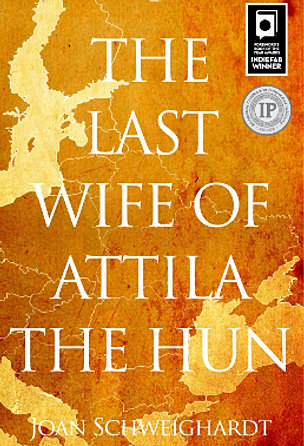
The Last Wife of Attila the Hun
By Joan Schweighardt
Booktrope Editions
September 24, 2015, ISBN-13: 978-1513702087, 272 pages
There are a number of versions of the Gudrun/Sigrid romance—some well-known such as Nibelungenlied which Wagner makes use of, Tolkien’s The Legend of Sigrid and Gudrun, “The Musician’s Tale” by Longfellow, and of course the classic Poetic Edda. Joan Schweighardt’s The Last Wife of Attila the Hun draws heavily on the legend, particularly the Edda, and though the setting is historical, set in the fifth century AD, there’s a freshness to her version that makes it exceptionally readable and enjoyable for the modern reader.
Gudrun is a powerful protagonist, and is both strong and vulnerable enough to carry the entire book with her first person narrative. She is a classic anti-hero, growing through tragedy and pain, rather than heroic impulse. In this version of the hero’s story, it is bravado and macho posturing that undoes the characters around Gudrun, including the beautiful Valkyria Brunhild, whom Gudrun learns to forgive. In fact, it’s forgiveness and love that makes Gudrun a heroine, and where her strength lies, not her great prowess or cunning.
Schweighardt’s research is impeccable, and her setting evocative, providing so much rich detail about life in the fifth century, that the reader becomes immersed in this world, from the food eaten, clothing worn, day to day activities, customs and prayers:
When the order was given, we formed a great circle, and as we tight- ened it, we drove the livestock into the center. Frightened by the closing in around them, the animals stomped and kicked and bellowed. The children among us squealed with delight to see them in such a frenzied state. Leafy garlands, fashioned by our servants, hung around the necks of the animals, and as the animals stirred, petals broke loose and u ered through the air like snow akes. When Gunner grabbed hold of the rst of the animals to be slaughtered, we lifted our voices and began to sing. We sang to Wodan and asked him to grant us a mild winter. (172)
Gudrun’s devotion to her Norse gods remains believable and moving, even when she meets up with a Christian who challenges her beliefs. Throughout the novel, we begin to look at each set of customs with Gudrun’s wonder:
In fact, there were some among my people who mutilated their own faces after the siege, believing this would make them as fierce as their attackers. Still, none of this had prepared me sufficiently to look upon them with my own eyes. Some wore tunics and breeches, not unlike the ones my own people wore. Others wore garments made entirely of marmot skins. With some on Roman horses and others on Hunnish ones, some dressed like Thuets and others in skins, they looked like no army I had ever seen before. Their confusion over how to respond to me only heightened the impression of disorder. (12)
The story is told in two separate narrative streams—one, ostensibly a flashback, though so subtly and clearly is the transition handled, that we are able to co-exist with Gudren as she moves between her narrative past and present, showing us the sequencing of events that brought us to the moment the two narrative streams connect. As the story progresses, the pace quickens, and though the ending is no surprise, Gudrun’s progression towards that ending, and the meta-fictional way in which she weaves her tale (both literally and metaphorically) is exquisite. Though the focus remains solely on Gudrun throughout the book, minor and secondary characters are also strong, and even the villains are delicately drawn, multi-dimensional and rich.
The Last Wife of Atilla the Hun manages the perfect balance between the epic setting from which it takes its cue, and the intimate and domestic world that Gudrun finds herself in. Gudrun is cut off from the battlefield from which she only hears news, and unlike Sigrid, doesn’t go on a quest for dragon’s gold. Unlike Brunhild, Gudrun is unable to cast magnificent runes or bewitch others. Nevertheless, she remains the story’s heroine, changes her reality several times, and her magic, though utterly grounded in talk, in servitude, and in observation, is the one that has impact. The Last Wife of Atilla the Hun is a deeply moving, perfectly written story that is both deeply rooted in history, legend and myth, and very much a story of today.